Epic, Bored Apes and the Story of the Metaverse
In Fortnite, you are INSIDE a narrative about the Metaverse. The Rift Tour may make that narrative even more explicit. But let's not forget about the Bored Apes. Because there's more than one story being played out.
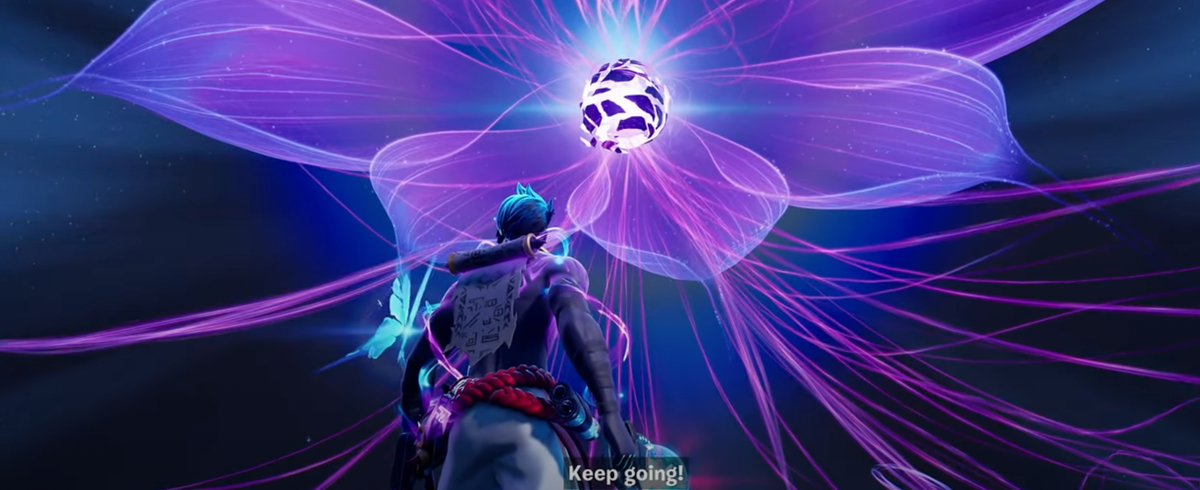
I find myself shooting at what I'm told aren't portals.
Reality is breaking down.
Waves of energy radiate around me, capable of changing anything in the blink of an eye. Jones has turned into a butterfly.
All this is happening after running through a gauntlet of licensed characters. Er, I mean attackers.
Creatures from Aliens and The Terminator, Kratos from God of War and a digital Sigourney Weaver were all part of pitched battles while the blue orb rotated overhead.
But instead of shooting at it, what I really, really want to do is jump through that little tear in the fabric of reality:

Until I remember that while this looks like Fortnite, I'm actually inside a narrative about the Metaverse. And we aren't ready to make that leap just yet.
Fortnite and The Rift Tour
This week, a 'superstar' will hold an event in Fortnite as part of the Rift Tour.
It's rumoured that Ariana Grande will 'perform' based on leaked court documents and the creative winks and nods ahead of the event.
We'll know more on Monday.
Regardless, the event has the potential scale of the Travis Scott concert which had 12.3 million concurrent 'attendees', 27.7 million unique players across 5 showtimes and 45.8 million views.
Those are the kinds of numbers that generated reams of news coverage. We had seen the future of the music industry, live events, and online social activities. And it was bigger than anyone expected.
The Rift Tour might not reach the same scale. But let's say it does. It promises:
A musical journey into magical new realities where Fortnite and a record-breaking superstar collide.
New realities?
Wasn't Zuckerberg talking about that?
While other companies have been suddenly talking a lot about the Metaverse, Ariana Grande (or whoever the record-breaking superstar is) might actually show us the way.
A Narrative ABOUT The Metaverse INSIDE The Metaverse
And that's what's potentially so profound about what Epic is doing with Fortnite. While Fortnite itself will NOT become the Metaverse on its own, it IS laying down some of the tracks to a time when all of our virtual worlds and galaxies are interconnected.
They're creating a mythology, a story, a game mechanic and a publishing schedule in support of their stated desire to make the Metaverse happen.
They aren't just expanding the size of their world, they're creating a mythology, language, and rationale for why it will happen and what its value will be.
And so the Rift Tour isn't interesting just because it might be a fun event with potentially millions of concurrent attendees. It's also interesting because:
- Epic will again have a chance to push the boundaries for the experience of attending an event in a virtual space. Travis Scott shattered many of the conventions of what a virtual performance can be. Think of it like some wild, slightly hallucinogenic Disney ride and you'll get the idea. It's all groundwork to answering a more important question than whether the Metaverse will be browser-based or viewed in VR: why will people show up? How do you make online spatial experiences entertaining and fun?
- Second, how does it tie in, if at all, to the larger Fortnite narrative? The fact that it's called the Rift Tour at least gives a passing nod to the idea. Because this narrative, in my view, doesn't just support playing the game, it's actually an uber-narrative about what the Metaverse is, translated in a language digestible to the 18-24 year olds who play.
A Complex Tale of Time, Power and Place
Now, let's be clear: the Fortnite narrative is complicated. It somehow manages to reconcile Batman (and manage a limited edition comic as a spin-off in the process) and Deadpool.
There are time loops, rifts, shadowy agencies and a ton of branded and licensed content.
At first glance, it mostly seems like a convoluted excuse to change the Island up every now and then, to launch new skins and cosmetic enhancements (their main source of revenue outside of sponsorship), to justify new enemy characters and weapons, and to create partnerships with Ferrari or Marvel.
It's a story of powerful forces trying to control access, superheroes arriving via rifts in reality, and...well, and YOU, a foot soldier struggling to survive yet another mission loop on a constantly changing island.
The narrative isn't really needed to play the game, anymore than you need to purchase a custom character.
This isn't Red Dead Redemption solo play where the story is the main driver of gameplay (I miss you, Dutch, delusional though you might have been!)
We're here for the fun. We're here to bash and shoot stuff with our friends. And we're here for the occassional concert or DJ gig.
The narrative mainly seems to server a larger purpose: it explains why, in spite (or because of) all these secret agents and heroes and mysterious portals, a lot of content can come IN but we can never really leave.
Until, maybe, the day that you can.
The Show Bible for the Metaverse
It's not like Epic is keeping this a secret.
In an interview with The Verge, creative creative officer Donald Mustard said that all those licensed characters were more than just an excuse to sell more skins:
"But Mustard says that it’s also a critical part of the storyline, nodding to something he and others at Epic have eagerly talked about creating — the Metaverse, comprised of characters and storylines from countless films, shows, and games all in one place.
Creating the Season 6 opener with the Russo Brothers, who know a thing or two about creating property-spanning universes, is another obvious nod in that direction.
Tim Sweeney, CEO of Epic, has been talking about Fortnite as something that transcends gaming, and has explicitly linked it to the Metaverse (the fact that one place he said this was in a court room just adds gravitas).
And so we return to the Rift Tour.
"A musical journey into magical new realities."
Ariana Grande might not let us go there after the concert is done, but she might hint that our ability to travel between worlds is on its way.
Tools, Film Grammar and Distribution
Movies can extend their 'film grammar' in part by changes in technology.
James Cameron is perhaps the most famous for this: Avatar, for example, was using Mandalorian-style technologies long before music stars were filming on LED stages. With real-time compositing, Cameron was able to see his actors ON the CGI sets during filming.
More profound shifts in the grammar of storytelling occur when we shift media. From radio to screen, from silent films to 'talkies', from network television to cable, and from TV to taped and streamed.
The transition to virtual worlds has resulted in a similar and profound shift in the 'grammar' of storytelling. This shift builds off of the profound advancements in game-based storytelling and other immersive arts. And it translates it through the lens of highly concurrent experiences.
These shifts in media create a cascade: changes in media are the results of advances in technology. More advances in technology provide new tools to storytellers. The storytellers get better at their craft, which attracts wider attention from the distributers, (whether movie theatres, cable channels or Playstation).
What Happens When You Own The Full Pipeline?
But what happens when one company is the company that builds the cameras and tells the stories and has the capacity to distribute them?
You now have the perfect virtuous circle: they can test the 'film grammar' of the new medium, refine gameplay, figure out how to hold a virtual concert, get data on user-generated content (through its Creative mode), and find out which licensed content 'pulls' more than others.
By providing the Unreal tools and the Epic marketplace to other developers they can both help to guide a shared library of best practices and learn from others.
They're not constrained to a particular film type like a movie studio would be. Because they're the ones making the film.
Oh, and they can also distribute the experience.
Epic's fight to get Fortnite on consoles was a genius-level achievement on par with what Steve Jobs did with the record companies for the iPod.
Launching their own app store helps to insulate them against - well, against things like Apple booting Fortnite from iOS.
A Story Built on a Road Map
And so Epic has a great deal of control over its product road map.
It knows how quickly it can develop new features for Unreal, it knows what pieces it's missing (and can acquire some of those pieces), and it can sequence changes to its payment systems, identity and log-in and marketplaces.
Fortnite is creating a mythology of a future Metaverse. Fortnite uses all of the technology that Epic creates. Fortnite therefore can 'attach' its storylines to that road map.
Tim Sweeney has made it clear, for example, that Fortnite is being transitioned to UE5. Will Fortnite take advantage of the advanced rendering and realism offered by Lumen and Nanite?
Would YOU?
Maybe you'd leave Fortnite Island alone and preserve the cartoon-ish gameplay. But maybe you'd create a storyline about how certain 'rifts' actually lead to highly realistic worlds.
Imagine jumping through a rift in Fortnite and landing in a "Thor World" spin-off: a highly detailed and rendered version of Asgard.
Myths and Stories Make The Metaverse
My nephew really doesn't care about the finer points of "what is the Metaverse".
By the time the Metaverse is actually here, we won't even need the name. We'll just be "in" the space which is online:

But imagine a 12 year old today spending time in Fortnite. Coupled with the dense cinematic universes of Marvel and Star Wars, these are the mythologies with which they're growing up (I'll leave aside cultural commentary).
They'll probably remember that they went to their first concert in Fortnite or Roblox the same way I remember seeing Supertramp. They'll probably remember interacting with their favourite characters or the month they ran around dressed as Deadpool.
The breadcrumbs and Easter Eggs were all there. They were participating in a story about the how and why worlds existed and how they became interconnected.
And if all of those worlds interconnect in a seamless way....then they'll have arrived in the Metaverse.
We just won't call it that. It will just appear.
One day you're hanging out with friends at an Ariana Grande concert and the next you're teleporting through the 'Rift' to visit Batman or to kill Aliens next to a digital Sigourney Weaver.
The only thing missing are the Bored Apes.
Stories from the Ground Up
There's another storyline. And it has nothing to do with Disney/Epic cross-licensing, Sony Music or using Unreal to recreate Mandalorian in your living room.
And it starts with the Bored Ape Yacht club:
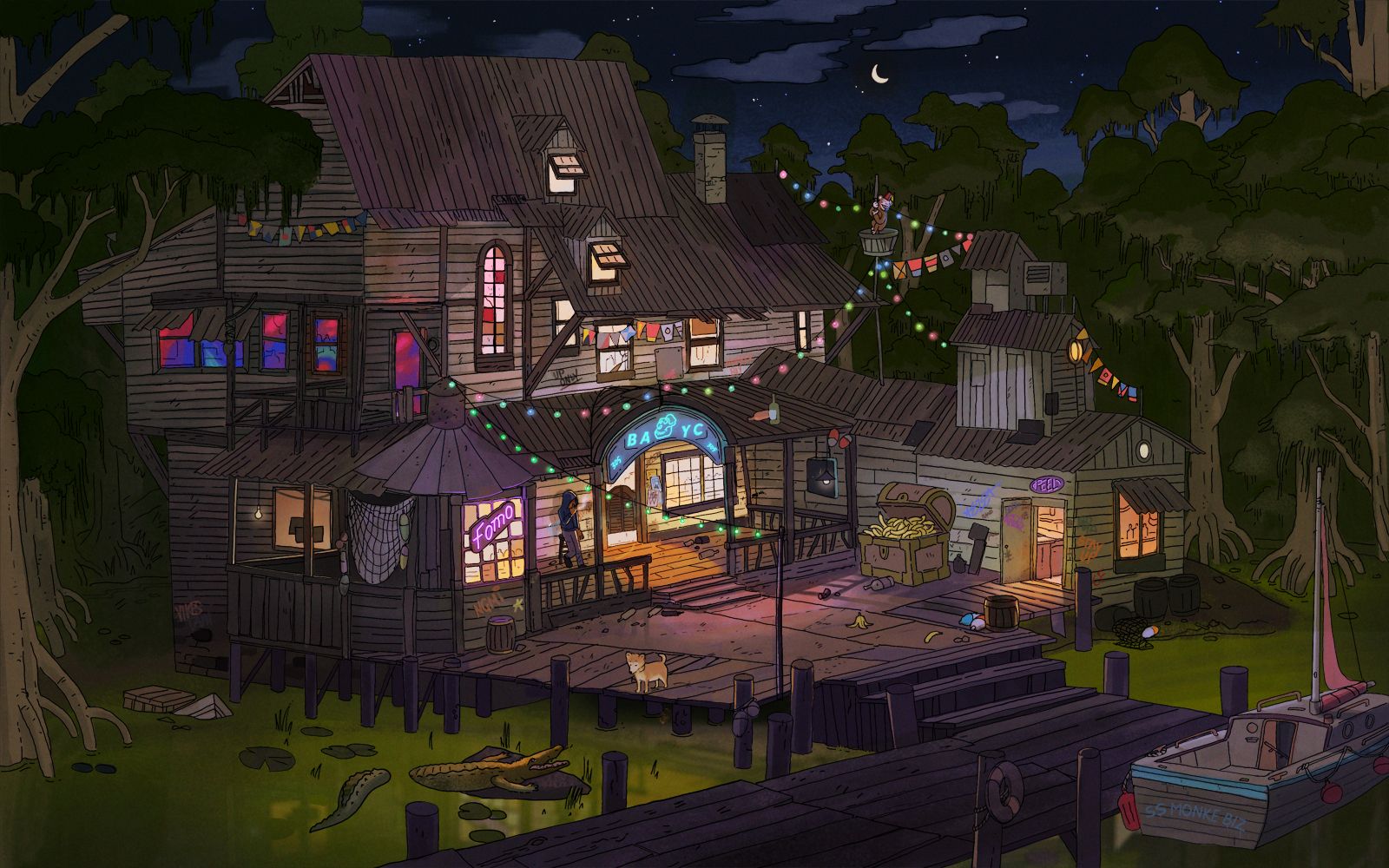
Instead of Marvel characters and Kratos it has...well, it has bored apes:
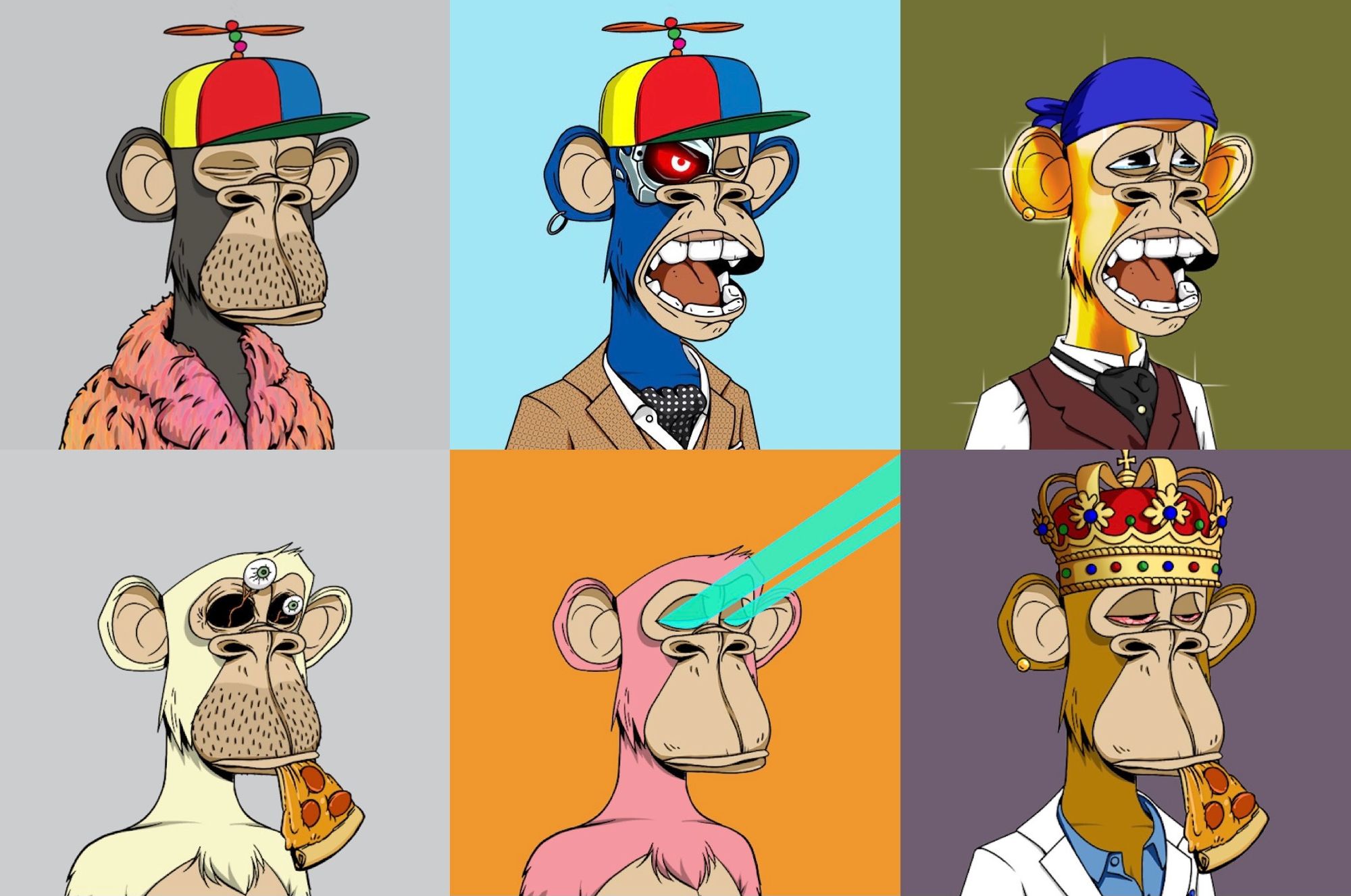
(Maybe the only cross-over thing here is the banana skin in Fortnite. I toyed with some sort of analogy about the Bored Apes eating Fortnite for lunch).
Now, at first glance, the Bored Apes seem like edgy cartoon characters. Much like the narrative in Fortnite, they don't seem like much more than an excuse for something else: to sell art work or t-shirts or craft beer.
In fact, they really aren't anything more than the above images. 10,000 of them.
But there has been almost $100 million in trading value for those images.
Sure, it's not quite the same money that Fortnite has pulled in.
And the Bored Apes don't really exist anywhere in particular.
You can't wear them like a skin in a virtual world. You pretty much just throw one up as your Twitter profile photo.
But scratch the surface and there's more to it. First, you're joining a 'club', a sort of fan community with its own benefits.
When a buyer makes his Twitter avatar an image...it’s a sign of allegiance, and also a signal to other buyers in the club to follow him on social media. (“I changed my picture to the ape and I got hundreds of Twitter followers the first day,” Swenson said.) The center of most clubs is Discord, the real-time chat app. Bored Ape Yacht Club’s Discord server has more than thirteen thousand members...The mutual investment, both social and financial, forms a kind of bond among club members within the wider Internet bedlam.
The creators of the Bored Apes had identified an opportunity: instead of simply creating limited series artworks and selling them “We were seeing the opportunities to make something with a larger story arc”. (Emphasis added).
As the New Yorker outlines it, these types of works :
...whether of people or monkeys or ghosts...were fairly generic. Bored Ape Yacht Club, by comparison, created rich and detailed iconography drawn from its founders’ personal tastes. The setting of an Everglades “yacht club” (an ironic appellation) was meant to evoke places like Churchill’s Pub, a well-worn Miami music venue that Gargamel and Goner frequented. “We were deeply inspired by eighties hardcore, punk rock, nineties hip-hop,” Goner said...From the scenes of an apocalyptic tiki bar on its Web site to the jaunty style of the apes themselves, Bored Ape Yacht Club felt more like the plans for a triple-A video game... The combination of sophisticated visuals, subcultural fashion accessories (shades of Hot Topic), and literary pretension made the Bored Ape universe catnip to a certain crypto-bro demographic."
And that crypto-bro demographic is important because the Bored Ape images are NFTs (non-fungible tokens).
Your ownership of one of the 10,000 apes is memorialized on the blockchain. There is one token per ape, and therefore only one person can "own" it at a time.
You can sell your NFT (your ape) off. Although be warned: the price keeps climbing. Digital scarcity has been created. You're joining an exclusive club....and it's a club of Bored Apes but it's a club nonetheless.
Membership has its privileges.
But aside from digital scarcity (which frankly can have echoes of the scarcity of Beanie Babies), there's something else that drives the success of Bored Apes.
Because by owning one, you can commercialize the asset:
(Bored Apes) was also one of the first clubs to offer individual buyers the commercial rights to the apes they own: each member is allowed to brand his own projects or products and sell them independently. In the three months since the club launched, Bored Ape owners have put the cartoon primates on lines of craft beer and created animated YouTube series, made painted replicas, and designed skateboard decks. Kyle Swenson, the clothing reseller, launched a publication called the Bored Ape Gazette, to cover the community.
The Primitives of the Metaverse
And so we start to see the other way that the story of the Metaverse unfolds.
At the level of Fortnite, a large-scale world is the backdrop for complex stories that unfold on a pre-determined schedule of chapters and seasons. The stories get bigger and bolder, the stars get bigger, the world changes...until other worlds are added, and we follow along, tracking the mythology of the Metaverse as it materializes around us.
At the level of Bored Apes, the Internet is rebuilt from the ground up with the primitives of story.
The story isn't preassembled. Instead, the components of the show bible are created, and instead of passing a copy off to a show runner or writer, they are auctioned off.
The only thing that was created were a bunch of primitives. How people assemble these primitives is an exercise in community building, commerce, collaboration and imagination.
This idea: that NFTs represent creative primitives, is comparable to the 'prims' of Second Life:
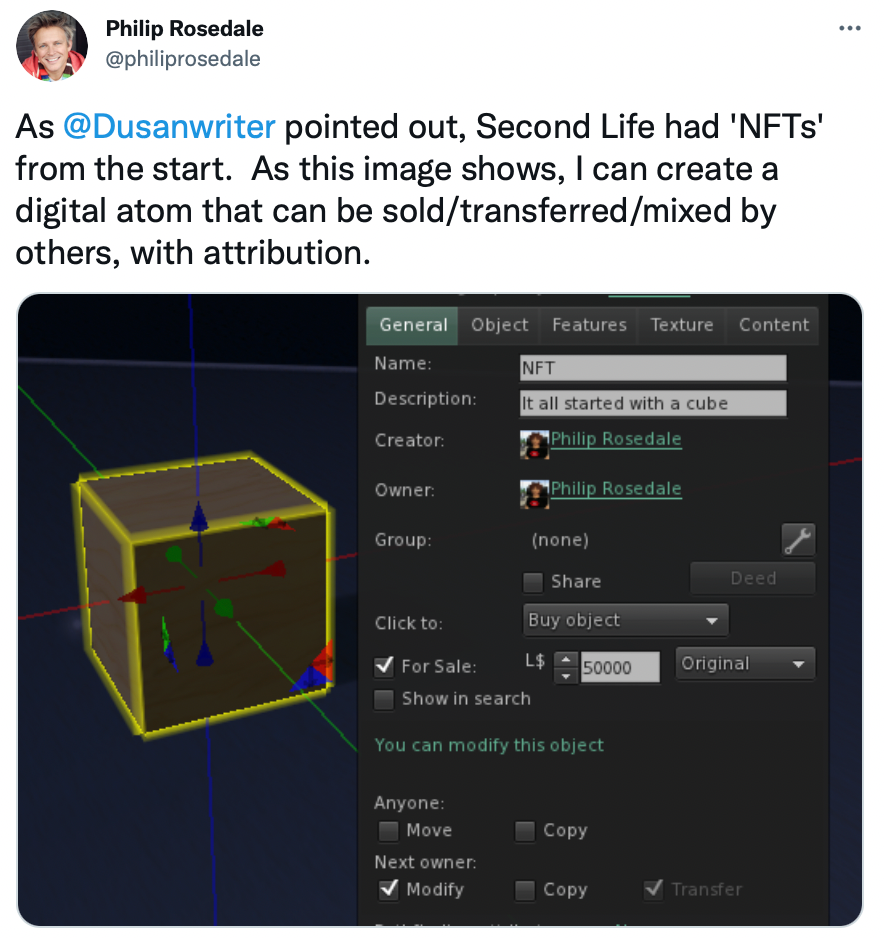
In Second Life the entire world was built from the prim up.
A cube could be shaped and connected to another cube. The resulting shape could have a texture thrown on top. Suddenly, you have a chair or table or dress.
The genius of the prim, however, lay in what Philip points out above: the permission system and the "For Sale" field.
Because once you've used your prims to create a dress, you can now sell it. And the next person has permissions for whether they can copy, modify or transfer that dress, and more importantly, they can include it in their own personal story.
They wear the dress to a wedding, they put the chair in their virtual house, they have dinner at the table with their family (other people, represented by avatars, living an often full second life).
NFTs As Creative Prims
NFTs have a bit of a definition problem, in the same way that the word 'Metaverse' can elicit strong reactions.
It's a technological affordance and a bunch of things can spin out of that affordance: from providing a trustworthy ledger for real-world art, for example, to creating speculative buying clubs for fancy JPEG art works through DAOs.
But let's focus on the Bored Apes (which, by the way, have inspired dozens of similar storylines).
The images at the heart of Bored Apes are just little granular pieces of content. They're not unlike prims.
They contain contracts for how they can be used. Their elements can be remixed, combined, and repurposed. They can be spun off into separate stories. They can be the basis of a new line of t-shirts or can be used like a high-signal version of the skins in Fortnite.
The promise of NFTs (and the blockchain) therefore is that we can create the primitives for large-scale storytelling.
And that the stories can travel further and reach more people. This is facilitated, first, because we can have 'skin in the game' (there's a financial upside, similar to how the dress maker in Second Life can sell the creation); and second because right now you don't need a particular skill set to change your Twitter profile in order to participate in the narrative.
The Road Map for NFTs
But just like Epic has a road map for its technology, there's a presumed/collective road map for the Bored Apes (and similar ventures).
Namely, that eventually, we'll move beyond remixing GIFs and JPEGs and start remixing larger and larger chunks of story.
The Bored Apes represent the ultimate unbundling of IP (think of all of those characters running around Fortnite) into its smallest components.
Eventually, those little chunks of story content will be easier to reassemble, view, display, remix and turn into story.
In the Bored Apes narrative of the future Metaverse, a demand will be created by the distributed nature of all of those little chunks of story.
As the pool of primitives grows and as more people own those primitives (whether unbundled IP from a big brand like Coke or a Bored Ape), we'll want a place to play, to create and to share.
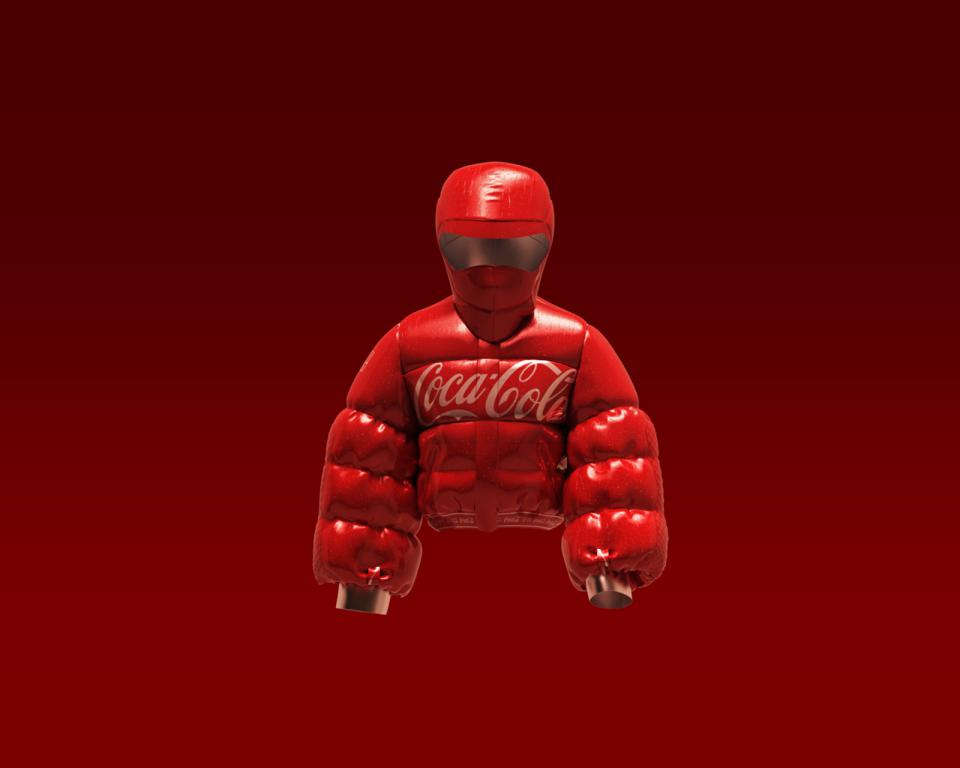
The owners of all of those Bored Apes and digital paintings and creative prims are going to demand a home. And the creators are going to demand better and more distributed tools to remix their primitives.
The Convergence of Story
This probably sounds like a showdown between Fortnite and the Bored Apes.
I don't believe it is.
It might be a showdown, of sorts, between different narratives. My recent post about the Metaverse generated - well, it generated a lot of discussion.
And aside from the highly technical reasons why it's important to 'get granular' about what we mean when we use the word "metaverse", it's an indicator that we all want a voice in our shared future.
Interconnected worlds are coming. Stories are being told about what those worlds will be, how they'll connect, and who will own the gates, experiences, and myths.
As I was writing this post, Tim Sweeney had this to say:
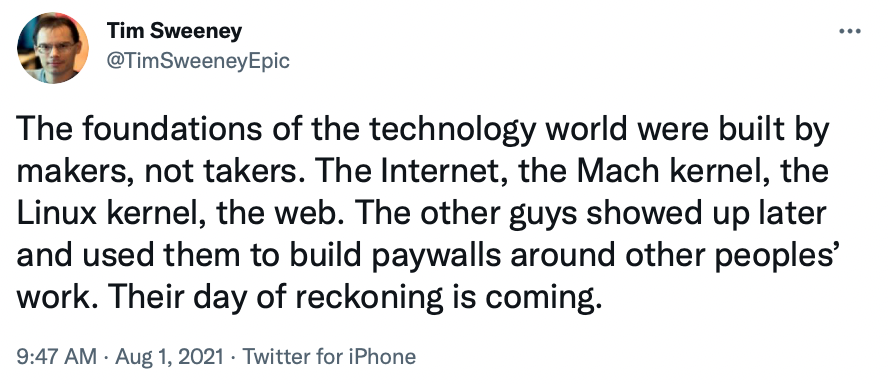
And I personally believe Tim when he says that we all benefit from a Metaverse that is open (which has has said many times). That it can't be owned by any one person.
The Primitives of Scans and 3D Content
I also believe that Fortnite isn't the only narrative that Epic is building. Yes, it's creating a particular mythology and storyline that leads us to a future in which worlds interconnect.
But so is Sketchfab, which Epic just purchased.
As I outlined in my post at the time, Sketchfab represents something more than just a marketplace for 3D content.
The photogrammetry that it hosts, for example, is another form of storytelling primitive. They are digital Polaroids which we'll eventually be able to collect, place, and co-create. They also represent the blurring of the lines between physical and digital realities.
Interconnected worlds won't just exist when you log in: they'll exist when you walk around the very real neighborhoods on the other side of your front door.
I actually believe that the narrative for Sketchfab and the narrative for Fortnite will converge: at some point, Epic will open everything up, and you'll be able to spin up your own island, or collect your own Sketchfab photo album, and you won't be locked into a proprietary "Unreal/Epic" model.
Epic will still make money entertaining and creating games (and helping other developers to do the same) but they will 'release' the 'kernels' for the Metaverse itself.
This Is The Moment The Story Changed
Today, we're seeing something that may, in the course of time, be more important than the emergence of edge networks or Lumen real-time rendering: we're all co-creating a shared mythology of what the Metaverse will be.
The narratives have "legs". We seem to have a hit or two on our hands.
We're collecting the creative primitives that will be used to build it while at the same time we're participating INSIDE a narrative about the interconnection of worlds.
And most of us are having a really, really fun time along the way.
Let's set a date for after the Rift has occurred and the worlds started to metastasize, grow and connect.
We'll share some stories about how we were there, back when the narrative of the Metaverse left behind the old tropes of 1990s science fiction (some of us got there sooner) and became something bigger, and more generous, and more fun.
Let's remember back to that time we saw Ariana Grande together and it made us feel like kids again. Let's remember how big the possibilities felt, whether we were hanging out in the virtual world of Discord at the Bored Apes Yacht Club, or were on an island dressed as a banana and we danced together.
Because really, there will be so many stories we'll be able to tell.